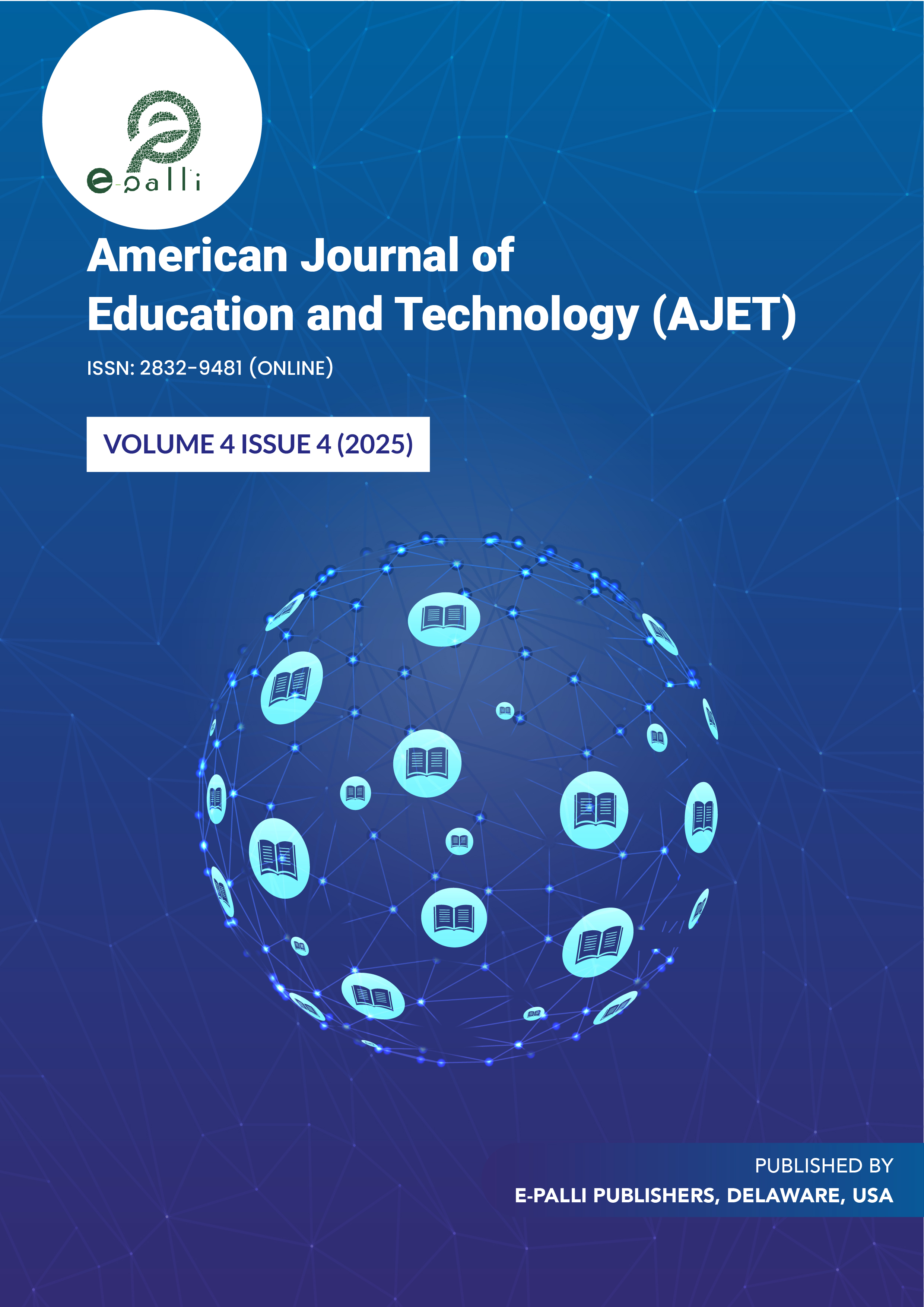The Role of Pre-recorded Lecture Length and Captioning in Shaping Business Students’ Learning and Engagement
DOI:
https://doi.org/10.54536/ajet.v4i4.5691Keywords:
Captioning, Covid-19 Pandemic, Learning Effectiveness, Online Learning, Pre-Recorded Lectures, Student PreferencesAbstract
Online education has seen substantial growth over the last few years, particularly in the context of the COVID-19 pandemic. The objective of this study was to investigate the impact of pre-recorded lecture duration and the availability of captioning on student engagement and learning effectiveness during the pandemic. Data was collected through a survey of both undergraduate and postgraduate business students at a British university’s partnership campus in Qatar. The results show that students prefer shorter recordings and perceive them as more useful for their learning. Furthermore, students indicated that captions are a very useful addition to pre-recorded video lectures, and that they use both video and captions together to enhance their learning experience. The findings offer valuable insights into the preferences and experiences of students within the context of an online learning environment. Pre-recorded short lectures with captions offer an advantageous learning environment for students, which educators can consider adopting in post-pandemic teaching practices as a more permanent feature.
Downloads
References
Adebesin, F., Mennega, N., & Botha, A. (2021). Leveraging the use of pre-recorded demonstration videos to support teaching and learning during Covid-19 lockdown.
Adedoyin, O. B., & Soykan, E. (2023). Covid-19 pandemic and online learning: the challenges and opportunities. Interactive learning environments, 31(2), 863-875.
Adnan, M., & Anwar, K. (2020). Online learning amid the COVID-19 pandemic: Students’ perspectives. Online Submission, 2(1), 45-51.
Ali, W. (2020). Online and remote learning in higher education institutes: A necessity in light of COVID-19 pandemic. Higher education studies, 10(3), 16-25.
Amini, A., Mardhiah, A., & Akrim, A. (2021). The Implementation of Online Learning Policy during the COVID-19 Pandemic at Dharmawangsa University. Jurnal Tarbiyah, 28(2), 123-136.
Asgari, S., Trajkovic, J., Rahmani, M., Zhang, W., Lo, R. C., & Sciortino, A. (2021). An observational study of engineering online education during the COVID-19 pandemic. Plos one, 16(4), e0250041.
Bernard, R. M., Abrami, P. C., Borokhovski, E., Wade, C. A., Tamim, R. M., Surkes, M. A., & Bethel, E. C. (2009). A meta-analysis of three types of interaction treatments in distance education. Review of Educational research, 79(3), 1243-1289.
Brown, S. (2022). Pre-recorded lectures–is anyone watching?. Front Educ Technol, 5(3), 43-48.
Chen, E., Kaczmarek, K., & Ohyama, H. (2020). Student perceptions of distance learning strategies during COVID‐19. Journal of dental education, 85(Suppl 1), 1190.
Cilesiz, S. (2015). Undergraduate students’ experiences with recorded lectures: towards a theory of acculturation. Higher Education, 69(3), 471-493.
Chisadza, C., Clance, M., Mthembu, T., Nicholls, N., & Yitbarek, E. (2021). Online and face‐to‐face learning: Evidence from students’ performance during the Covid‐19 pandemic. African Development Review, 33, S114-S125.
Chung, E., Subramaniam, G., & Dass, L. C. (2020). Online learning readiness among university students in Malaysia amidst COVID-19. Asian Journal of University Education, 16(2), 46-58.
Djidu, H., Mashuri, S., Nasruddin, N., Sejati, A.E., Rasmuin, R., Ugi, L.E. and Arua, A.L. (2021). Online learning in the post-COVID-19 pandemic era: Is our higher education ready for it? Jurnal Penelitian dan Pengkajian Ilmu Pendidikan: e-Saintika, 5(2), 139–151.
Dona, K. L., Gregory, J., & Pechenkina, E. (2017). Lecture-recording technology in higher education: Exploring lecturer and student views across the disciplines. Australasian Journal of Educational Technology, 33(4).
Faize, F. A., & Nawaz, M. (2020). Evaluation and improvement of students’ satisfaction in online learning during COVID-19. Open praxis, 12(4), 495-507.
Febrianto, P. T., Mas’udah, S., & Megasari, L. A. (2020). Implementation of online learning during the covid-19 pandemic on Madura Island, Indonesia. International Journal of Learning, Teaching and Educational Research, 19(8), 233-254.
Gupta, M. M. (2021). Impact of Coronavirus Disease (COVID-19) pandemic on classroom teaching: Challenges of online classes and solutions. Journal of education and health promotion, 10(1), 155.
Hamdan, M., Jaidin, J. H., Fithriyah, M., & Anshari, M. (2020, December). E-learning in time of COVID-19 pandemic: Challenges & experiences. In 2020 sixth international conference on e-learning (econf) (pp. 12-16).
Hassan, M. K. (2021). Online teaching challenges during COVID-19 pandemic. International Journal of Information and Education Technology, 11(1), 10-18178.
Garrison, D. R. (1989). Understanding distance education: A framework for the future. Routledge.
Islam, M., Kim, D. A., & Kwon, M. (2020). A comparison of two forms of instruction: Pre-recorded video lectures vs. live ZOOM lectures for education in the business management field. Sustainability, 12(19), 8149.
Kayyali, M. (2024). Quality Assurance in Online and Blended Learning Environments. In Quality Assurance and Accreditation in Higher Education: Issues, Models, and Best Practices (pp. 227-292). Cham: Springer Nature Switzerland.
Kirschner, P. A. (2002). Cognitive load theory: Implications of cognitive load theory on the design of learning. Learning and instruction, 12(1), 1-10.
Lapitan Jr, L. D., Tiangco, C. E., Sumalinog, D. A. G., Sabarillo, N. S., & Diaz, J. M. (2021). An effective blended online teaching and learning strategy during the COVID-19 pandemic. Education for chemical engineers, 35, 116-131.
Le, K. (2022). Pre-recorded lectures, live online lectures, and student academic achievement. Sustainability, 14(5), 2910.
Li, D. (2022). The Shift to Online Classes during the COVID-19 Pandemic: Benefits, Challenges, and Required Improvements from the Students’ Perspective. Electronic Journal of E-Learning, 20(1), 1-18.
Mayer, R. E. (Ed.). (2005). The Cambridge handbook of multimedia learning. Cambridge university press.
Mayer, R. E. (2017). Using multimedia for e‐learning. Journal of computer assisted learning, 33(5), 403-423.
Nambiar, D. (2020). The impact of online learning during COVID-19: students’ and teachers’ perspective. The international journal of Indian psychology, 8(2), 783-793.
O’Callaghan, F. V., Neumann, D. L., Jones, L., & Creed, P. A. (2017). The use of lecture recordings in higher education: A review of institutional, student, and lecturer issues. Education and Information Technologies, 22(1), 399-415.
Oyedotun, T. D. (2020). Sudden change of pedagogy in education driven by COVID-19: Perspectives and evaluation from a developing country. Research in Globalization, 2, 100029.
Pokhrel, S., & Chhetri, R. (2021). A literature review on impact of COVID-19 pandemic on teaching and learning. Higher education for the future, 8(1), 133-141.
Prastuti, E. (2020). Student Optimism Regarding Online Learning During the Covid-19 Pandemic. KnE Social Sciences, 187-194.
Ranchal, R., Taber-Doughty, T., Guo, Y., Bain, K., Martin, H., Robinson, J. P., & Duerstock, B. S. (2013). Using speech recognition for real-time captioning and lecture transcription in the classroom. IEEE Transactions on Learning Technologies, 6(4), 299-311.
Prastuti, E. (2021). Student Optimism Regarding Online Learning During the Covid-19 Pandemic. KnE Social Sciences. https://doi.org/10.18502/kss.v4i15.8204.
Robson, L., Gardner, B., & Dommett, E. J. (2022). The post-pandemic lecture: Views from academic staff across the UK. Education sciences, 12(2), 123.
Sepulveda-Escobar, P., & Morrison, A. (2020). Online teaching placement during the COVID-19 pandemic in Chile: challenges and opportunities. European Journal of Teacher Education, 43(4), 587-607.
Simamora, R. M. (2020). The Challenges of online learning during the COVID-19 pandemic: An essay analysis of performing arts education students. Studies in Learning and Teaching, 1(2), 86-103.
Simamora, R. M., De Fretes, D., Purba, E. D., & Pasaribu, D. (2020). Practices, challenges, and prospects of online learning during Covid-19 pandemic in higher education: Lecturer perspectives. Studies in Learning and Teaching, 1(3), 185-208.
Stevanović, A., Božić, R., & Radović, S. (2021). Higher education students’ experiences and opinion about distance learning during the Covid‐19 pandemic. Journal of computer assisted learning, 37(6), 1682-1693.
Susilowati, R. (2020). The challenges of online learning in listening class during Covid-19 pandemic. Edukasi Lingua Sastra, 18(2), 56-72.
Syynimaa, N. (2019). Does replacing face-to-face lectures with pre-recorded video lectures affect learning outcomes?
Tang, Y. M., Chen, P. C., Law, K. M., Wu, C. H., Lau, Y. Y., Guan, J., ... & Ho, G. T. (2021). Comparative analysis of Student’s live online learning readiness during the coronavirus (COVID-19) pandemic in the higher education sector. Computers & education, 168, 104211.
Turnbull, D., Chugh, R., & Luck, J. (2021). Transitioning to E-Learning during the COVID-19 pandemic: How have Higher Education Institutions responded to the challenge?. Education and Information Technologies, 26(5), 6401-6419.
Wang, X., Liu, T., Wang, J., & Tian, J. (2022). Understanding learner continuance intention: A comparison of live video learning, pre-recorded video learning and hybrid video learning in COVID-19 pandemic. International Journal of Human–Computer Interaction, 38(3), 263-281.
Weidman, J. C., Twale, D. J., & Stein, E. L. (2001). Socialization of graduate and professional students in higher education: A perilous passage? (ASHE-ERIC Higher Education Report, Vol. 28, No. 3). Jossey-Bass.
Yatigammana, K., & Wijayarathna, G. (2021). Students’ perceptions of online lecture delivery modes: Higher education during Covid-19 pandemic and beyond. International Journal of Emerging Technologies in Learning (iJET), 16(21), 58-73.
Downloads
Published
How to Cite
Issue
Section
License
Copyright (c) 2025 Shahadat Hossain, Florian Meier

This work is licensed under a Creative Commons Attribution 4.0 International License.








